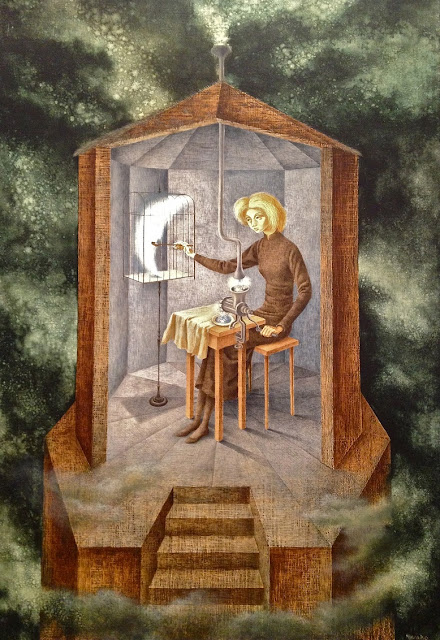 She differed from other Surrealists because of her constant use of religion in her work. She also turned to a wide range of mystic and hermetic traditions, both Western and non-Western for influence. She was influenced by her belief in magic and animistic faiths. She was very connected to nature and believed that there was strong relation between the plant, human, animal, and mechanical world. Her belief in mystical forces greatly influenced her paintings. Varo was aware of the importance of biology, chemistry, physics and botany, but thought it should blend together with other aspects of life.
She differed from other Surrealists because of her constant use of religion in her work. She also turned to a wide range of mystic and hermetic traditions, both Western and non-Western for influence. She was influenced by her belief in magic and animistic faiths. She was very connected to nature and believed that there was strong relation between the plant, human, animal, and mechanical world. Her belief in mystical forces greatly influenced her paintings. Varo was aware of the importance of biology, chemistry, physics and botany, but thought it should blend together with other aspects of life.She turned with equal interest to the ideas of Carl Jung as to the theories of George Gurdjieff, P. D. Ouspensky, Helena Blavatsky, Meister Eckhart and the Sufis, and was as fascinated with the legend of the Holy Grail as with sacred geometry, alchemy and the I Ching. In 1938 and 1939 Varo joined her closest companions Frances, Roberto Matta and Gordon Onslow Ford in exploring the fourth dimension, basing much of their studies off of Ouspensky's book Tertium Oganum. The books Illustrated Anthology of Sorcery, Magic and Alchemy by Grillot de Givry and The History of Magic and the Occult by Kurt Seligmann were highly valued in Breton's Surrealist circle. She saw in each of these an avenue to self-knowledge and the transformation of consciousness.
She was also greatly influence by her childhood journeys. She often depicted out of the ordinary vehicles in mystifying lands. These works echo her family travels in her childhood.Wikipedia

















No comments:
Post a Comment